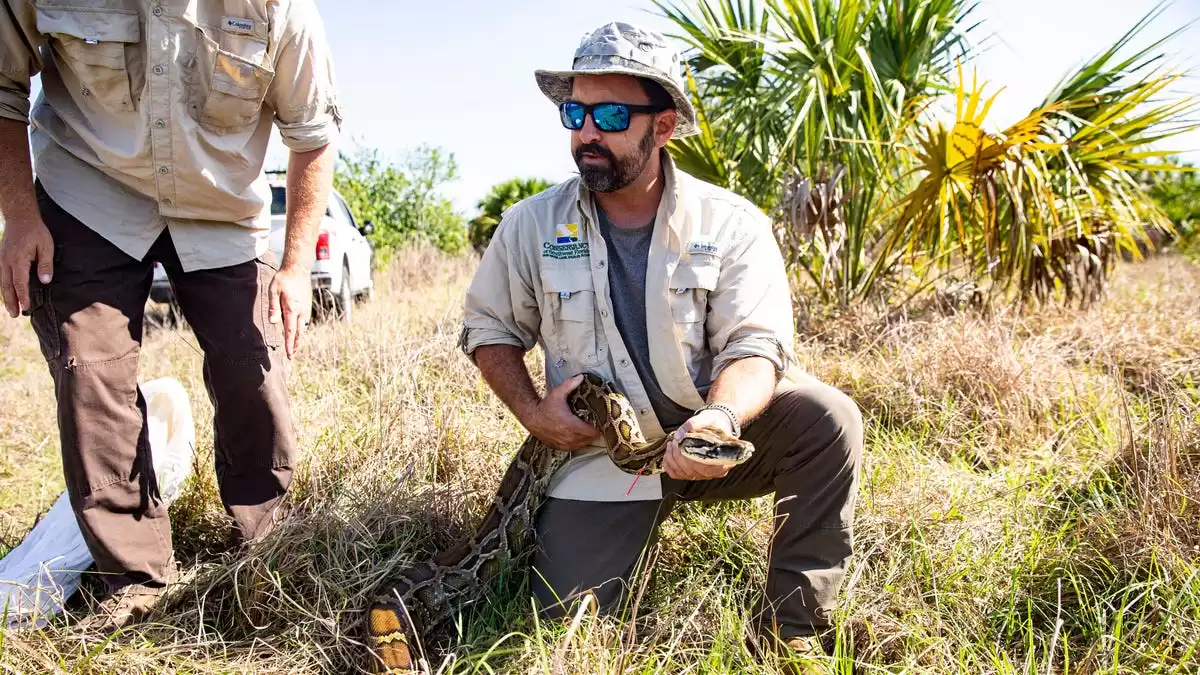USGS finds that Florida's Burmese pythons are a blend of different species
Burmese pythons in South Florida have Indian python genetics.
Biologists at the Conservancy of Southwest Florida in Naples are studying the pythons in South Florida to gain a better understanding of their impact on the local ecosystems. For years, Burmese pythons have been causing significant damage to the region's wildlife, with reports suggesting that they have consumed almost all of the fur-bearing animals in the Everglades. However, recent discoveries have revealed that a small percentage of the snakes in South Florida also have Indian python genetics, making them a unique breed. Burmese pythons are known to grow up to 20 feet in length and weigh around 200 pounds, consuming a wide range of animals in their habitat. On the other hand, Indian pythons are larger than native Florida snakes, reaching lengths of up to 10 feet and weighing nearly 30 pounds. Both species are native to Asia, with the Burmese python primarily found in Eastern Asia and the Indian python mainly found in India. These snakes are solitary hunters that thrive in semi-tropical environments like South Florida.
Invasive species often have an advantage over native wildlife, as they typically lack natural predators. While smaller pythons may be preyed upon by other animals, larger ones like the Burmese python can roam freely without fear of being attacked. The combination of genetics from two closely related species can result in an animal that can quickly adapt to a foreign environment. This may explain the presence of pythons with Indian genetics in Florida, as suggested by a report from the United States Geological Survey. Dealing with invasive animals and plants across the United States costs billions of dollars annually, and Florida is home to many non-native species.
Some media outlets have referred to the mixture of genetics in these snakes as a "super snake." However, Ian Bartoszek, a biologist and python expert at the Conservancy of Southwest Florida, disagrees with this portrayal. He believes that most of the genetic mixing likely occurred before the snakes were released into the wild. Bartoszek argues that the snakes have simply adapted to Florida's ecosystems and that there is nothing particularly "super" about them. It is still unknown whether the genetic combination conveys any special abilities to the snakes.
Records show that approximately 100,000 Burmese pythons were imported to the United States since the late 1970s, primarily from Vietnam and Thailand. The pet trade may have played a role in the mixing of genetics in these snakes. Bartoszek is more concerned with how the wild snakes have adapted to their new environment and whether they possess traits that make them better suited for Florida. He believes that there are selection events occurring in the wild that are shaping the snakes' characteristics.
One concern is that these pythons, whether they are Burmese or a hybrid of Burmese and Indian pythons, may spread northward into other parts of Florida and potentially beyond. The ability of the snakes to tolerate colder temperatures will depend on the adaptations they undergo in the wild. Some snakes may be better at hiding and seeking shelter in burrows, allowing them to wait out cold events. Bartoszek suggests that these adaptations, along with the availability of ecological niches in the Everglades, have made the Burmese python a perfect fit for the region. Florida is a relatively young area ecologically, having emerged from the seas only a few thousand years ago, while regions like the Amazon have evolved over millions of years. This youthfulness may have created open niches that invasive species like the Burmese python can exploit.
In conclusion, biologists in Southwest Florida are studying the pythons in order to gain insights into their impact on the local ecosystems. The presence of Indian python genetics in the South Florida snake population suggests a unique breed has emerged. These snakes, particularly the Burmese python, have caused significant damage to the region's wildlife. The adaptation and genetic mixing of these snakes may have contributed to their success as an invasive species. The potential spread of these snakes to other parts of Florida and their ability to tolerate colder temperatures are ongoing concerns. Overall, the study of these pythons provides valuable information about invasive species and their impact on ecosystems.












Comments on USGS finds that Florida's Burmese pythons are a blend of different species